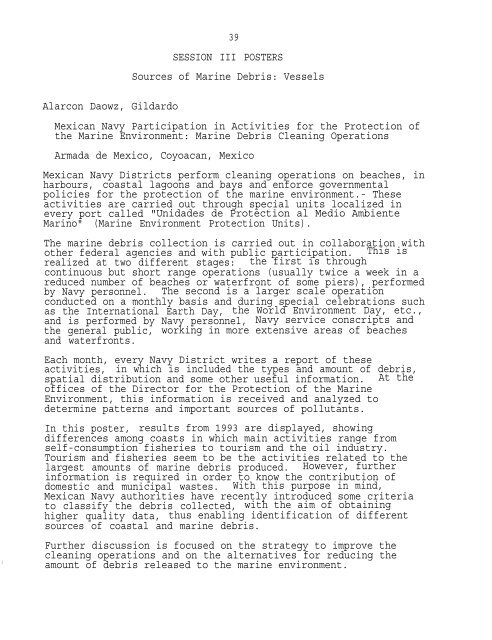Poster abstracts and manuscripts from the Third International ...
Poster abstracts and manuscripts from the Third International ...
Poster abstracts and manuscripts from the Third International ...
You also want an ePaper? Increase the reach of your titles
YUMPU automatically turns print PDFs into web optimized ePapers that Google loves.
Alarcon Daowz, Gildardo<br />
39<br />
SESSION III POSTERS<br />
Sources of Marine Debris: Vessels<br />
Mexican Navy Participation in Activities for <strong>the</strong> Protection of<br />
<strong>the</strong> Marine Environment: Marine Debris Cleaning Operations<br />
Armada de Mexico, Coyoacan, Mexico<br />
Mexican Navy Districts perform cleaning operations on beaches, in<br />
harbours, coastal lagoons <strong>and</strong> bays <strong>and</strong> enforce governmental<br />
policies for <strong>the</strong> protection of <strong>the</strong> marine environment.- These<br />
activities are carried out through special units localized in<br />
every port called "Unidades de Protection al Medio Ambiente<br />
Marino" (Marine Environment Protection Units).<br />
The marine debris collection is carried out in collaboration with<br />
o<strong>the</strong>r federal agencies <strong>and</strong> with public participation. This is<br />
realized at two different stages: <strong>the</strong> first is through<br />
continuous but short range operations (usually twice a week in a<br />
reduced number of beaches or waterfront of some piers), performed<br />
by Navy personnel. The second is a larger scale operation<br />
conducted on a monthly basis <strong>and</strong> during special celebrations such<br />
as <strong>the</strong> <strong>International</strong> Earth Day, <strong>the</strong> World Environment Day, etc.,<br />
<strong>and</strong> is performed by Navy personnel, Navy service conscripts <strong>and</strong><br />
<strong>the</strong> general public, working in more extensive areas of beaches<br />
<strong>and</strong> waterfronts.<br />
Each month, every Navy District writes a report of <strong>the</strong>se<br />
activities, in which is included <strong>the</strong> types <strong>and</strong> amount of debris,<br />
spatial distribution <strong>and</strong> some o<strong>the</strong>r useful information. At <strong>the</strong><br />
offices of <strong>the</strong> Director for <strong>the</strong> Protection of <strong>the</strong> Marine<br />
Environment, this information is received <strong>and</strong> analyzed to<br />
determine patterns <strong>and</strong> important sources of pollutants.<br />
In this poster, results <strong>from</strong> 1993 are displayed, showing<br />
differences among coasts in which main activities range <strong>from</strong><br />
self-consumption fisheries to tourism <strong>and</strong> <strong>the</strong> oil industry.<br />
Tourism <strong>and</strong> fisheries seem to be <strong>the</strong> activities related to <strong>the</strong><br />
largest amounts of marine debris produced. However, fur<strong>the</strong>r<br />
information is required in order to know <strong>the</strong> contribution of<br />
domestic <strong>and</strong> municipal wastes. With this purpose in mind,<br />
Mexican Navy authorities have recently introduced some criteria<br />
to classify <strong>the</strong> debris collected, with <strong>the</strong> aim of obtaining<br />
higher quality data, thus enabling identification of different<br />
sources of coastal <strong>and</strong> marine debris.<br />
Fur<strong>the</strong>r discussion is focused on <strong>the</strong> strategy to improve <strong>the</strong><br />
cleaning operations <strong>and</strong> on <strong>the</strong> alternatives for reducing <strong>the</strong><br />
amount of debris released to <strong>the</strong> marine environment.
















